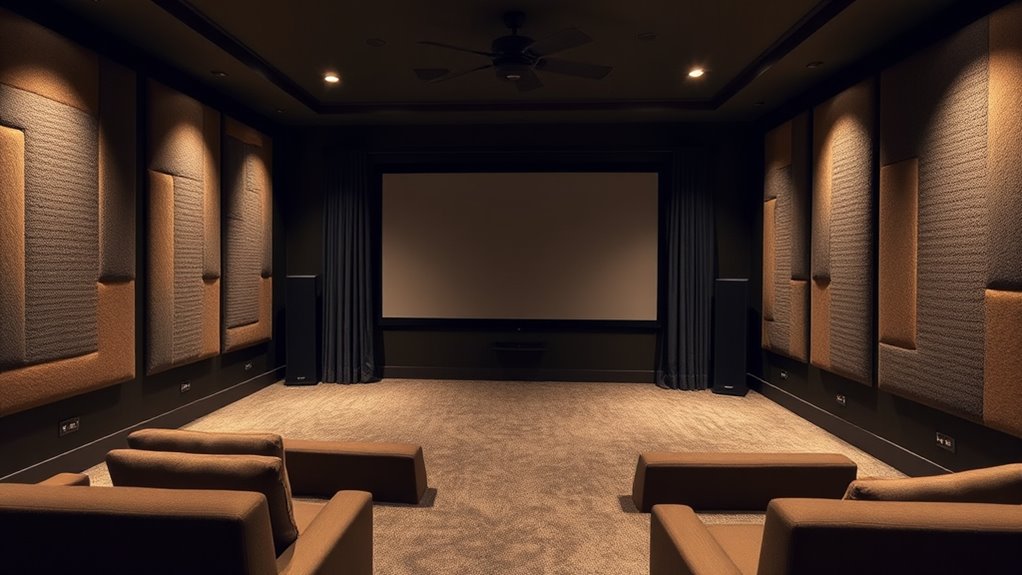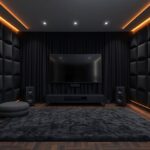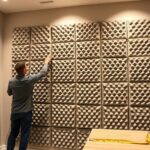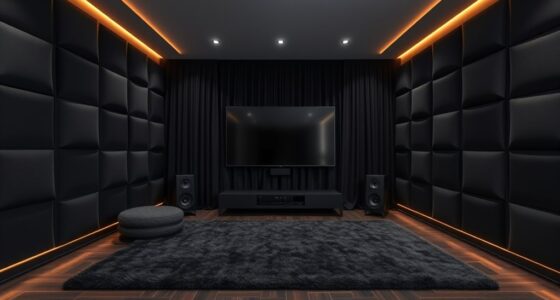To soundproof your home theater, focus on sealing gaps around doors and windows with weatherstripping or acoustic caulk, and add door seals for better insulation. Install acoustic panels on walls facing neighboring rooms or thin walls to absorb sound. Cover vents and seal any leaks to prevent noise escape. Combining these measures creates a quieter, more immersive space. Keep exploring to discover more practical tips for honing your home theater’s soundproofing!
Key Takeaways
- Install acoustic panels strategically on walls facing neighboring rooms to absorb sound and reduce echoes.
- Seal gaps around doors and windows with weatherstripping or acoustic caulk to prevent sound leaks.
- Use door seals or replace with solid-core doors for better sound insulation.
- Cover vents and seal weak points like thin walls or gaps to block noise escape.
- Combine multiple measures, such as acoustic panels and sealed doors, for maximum soundproofing effectiveness.

Creating a home theater offers an immersive experience, but unwanted noise can disrupt your enjoyment and disturb others. To keep the sound contained, you’ll want to start with effective soundproofing measures. One of the most straightforward ways is to add acoustic panels. These panels absorb sound waves, reducing echoes and preventing noise from escaping the room. When you install acoustic panels on the walls, you’ll notice a significant difference in sound clarity inside your theater and less sound leakage outside. Choose panels that match your decor or are acoustically effective to maximize both form and function. Position them strategically—on the walls facing neighboring rooms or thin walls—to improve sound absorption where it counts most.
Adding acoustic panels enhances sound clarity and reduces noise escape in your home theater.
In addition to acoustic panels, paying attention to door seals is vital. Doors are often weak points in soundproofing because they allow sound to pass through gaps. Installing door seals creates a tight barrier, blocking noise from escaping or entering the room. You can use weatherstripping or specialized acoustic door seals, which are easy to apply and cost-effective. Make sure the seals are continuous along the door frame, covering all gaps around the edges. This prevents sound from leaking through the cracks, especially when playing loud audio or using a powerful speaker system. If your door doesn’t fit perfectly in the frame, consider replacing it with a solid-core door or adding an extra panel to improve sound isolation.
Combining acoustic panels with properly sealed doors provides a double layer of soundproofing that’s highly effective. When you do this, you create a more controlled environment where sound stays contained, allowing you to enjoy movies at higher volumes without disturbing others. Remember, the key is to address all potential weak points in the room’s structure. Besides doors and walls, check windows and vents, sealing them with acoustic caulk or specialized covers. These small adjustments make a big difference in your overall soundproofing efforts. Additionally, using materials like recycled products for DIY acoustic treatments can be an eco-friendly and cost-effective option.
Ultimately, soundproofing your home theater isn’t about making it completely soundproof but about minimizing noise leakage and improving sound quality inside the room. Acoustic panels and door seals are among the most practical and impactful solutions you can implement. They’re relatively easy to install and offer noticeable results in both sound clarity and privacy. By focusing on these elements, you’ll create a dedicated space where you can enjoy movies and music at any volume, without bothering your household or neighbors.
Frequently Asked Questions
Can Soundproofing Improve Overall Room Acoustics?
Yes, soundproofing can improve your room’s overall acoustics. By reducing acoustic reflection, you prevent echoes that distort sound clarity. Adding soundproofing materials like acoustic panels absorbs excess noise, creating a more balanced environment. Additionally, sound masking devices can help control ambient noise, making sound more consistent. Together, these strategies enhance your room’s acoustics, making it more pleasant for listening and reducing sound disturbances for others nearby.
What Are Cost-Effective Soundproofing Options for Small Budgets?
If you’re on a small budget, consider budget-friendly solutions like adding heavy curtains or rugs to absorb sound. DIY soundproofing is also effective—try sealing gaps with weatherstripping or using foam panels you can install yourself. These options help reduce noise without spending much, making your home theater quieter and more immersive. Focus on sealing leaks and adding soft materials to get the best results with minimal expense.
How Long Does It Take to Install Soundproofing in a Home Theater?
Like Da Vinci sketching his masterpieces, your installation timeline depends on your project’s scope. If you plan carefully, small DIY soundproofing can take a weekend, while larger upgrades might span a few days to a week. Effective project planning helps you allocate time efficiently, minimizing delays. Overall, expect the process to take from a couple of days to a week, ensuring each step is thoughtfully executed for the best soundproofing results.
Are There Eco-Friendly Soundproofing Materials Available?
Yes, eco-friendly soundproofing materials are available. You can recycle acoustic panels made from recycled materials or opt for natural insulation options like sheep’s wool, cotton, or cellulose. These materials effectively reduce noise while being sustainable and non-toxic. By choosing these eco-friendly options, you not only improve your home theater’s soundproofing but also contribute to environmental conservation. It’s a smart, green choice for your space.
Will Soundproofing Affect the Room’s Ventilation or Airflow?
Like a whisper in a cathedral, soundproofing typically won’t affect your room’s ventilation impact or airflow considerations if you choose the right materials and techniques. Properly installed soundproofing can maintain good airflow while reducing noise. However, sealing all gaps might limit ventilation if not done carefully. To avoid this, incorporate vented panels or soundproof ducts, ensuring your home theater stays quiet without sacrificing fresh air.
Conclusion
Remember, a well-soundproofed home theater enhances your experience and keeps noise contained. By sealing gaps, adding insulation, and choosing the right materials, you can enjoy immersive sound without disturbing others. Don’t forget, “A chain is only as strong as its weakest link,” so address every potential entry point for sound. With these tips, you’ll create a perfect private sanctuary for movie nights and gaming marathons. Happy streaming and happy relaxing!















